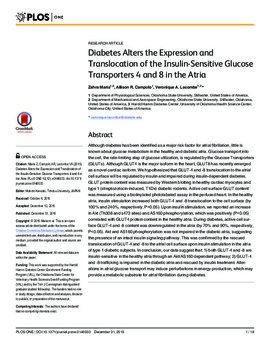| dc.contributor.author | Zahra Maria | |
| dc.contributor.author | Allison R. Campolo | |
| dc.contributor.author | Veronique A. Lacombe | |
| dc.date.accessioned | 2017-03-05T22:55:26Z | |
| dc.date.available | 2017-03-05T22:55:26Z | |
| dc.date.issued | 2015-12-31 | |
| dc.identifier.citation | Maria Z, Campolo AR, Lacombe VA (2015) Diabetes Alters the Expression and Translocation of the Insulin-Sensitive Glucose Transporters 4 and 8 in the Atria. PLoS ONE 10(12): e0146033. doi:10.1371/journal.pone.0146033 | en_US |
| dc.identifier.uri | https://hdl.handle.net/11244/49285 | |
| dc.description | We would like to thank Dr. Emilie Martinez and Jill Murray for their excellent technical assistance and animal care. | en_US |
| dc.description | | en_US |
| dc.description.abstract | Although diabetes has been identified as a major risk factor for atrial fibrillation, little is known about glucose metabolism in the healthy and diabetic atria. Glucose transport into the cell, the rate-limiting step of glucose utilization, is regulated by the Glucose Transporters (GLUTs). Although GLUT4 is the major isoform in the heart, GLUT8 has recently emerged as a novel cardiac isoform. We hypothesized that GLUT-4 and -8 translocation to the atrial cell surface will be regulated by insulin and impaired during insulin-dependent diabetes. GLUT protein content was measured by Western blotting in healthy cardiac myocytes and type 1 (streptozotocin-induced, T1Dx) diabetic rodents. Active cell surface GLUT content was measured using a biotinylated photolabeled assay in the perfused heart. In the healthy atria, insulin stimulation increased both GLUT-4 and -8 translocation to the cell surface (by 100% and 240%, respectively, P<0.05). Upon insulin stimulation, we reported an increase in Akt (Th308 and s473 sites) and AS160 phosphorylation, which was positively (P<0.05) correlated with GLUT4 protein content in the healthy atria. During diabetes, active cell surface GLUT-4 and -8 content was downregulated in the atria (by 70% and 90%, respectively, P<0.05). Akt and AS160 phosphorylation was not impaired in the diabetic atria, suggesting the presence of an intact insulin signaling pathway. This was confirmed by the rescued translocation of GLUT-4 and -8 to the atrial cell surface upon insulin stimulation in the atria of type 1 diabetic subjects. In conclusion, our data suggest that: 1) both GLUT-4 and -8 are insulin-sensitive in the healthy atria through an Akt/AS160 dependent pathway; 2) GLUT-4 and -8 trafficking is impaired in the diabetic atria and rescued by insulin treatment. Alterations in atrial glucose transport may induce perturbations in energy production, which may provide a metabolic substrate for atrial fibrillation during diabetes. | en_US |
| dc.language.iso | en_US | en_US |
| dc.publisher | PLos One | |
| dc.relation.ispartofseries | PLoS ONE 10(12): e0146033 | |
| dc.relation.uri | http://www.plosone.org/article/info%3Adoi%2F10.1371%2Fjournal.pone.0146033 | |
| dc.rights | Attribution 3.0 United States | |
| dc.rights.uri | https://creativecommons.org/licenses/by/3.0/us/ | |
| dc.subject | Diabetes mellitus,Insulin,Membrane proteins,Glucose,Insulin signaling,Protein expression,Type 1 diabetes,Muscle cells | en_US |
| dc.title | Diabetes Alters the Expression and Translocation of the Insulin-Sensitive Glucose Transporters 4 and 8 in the Atria | en_US |
| dc.type | Research Article | en_US |
| dc.description.peerreview | Yes | en_US |
| dc.description.peerreviewnotes | http://www.plosone.org/static/editorial#peer | en_US |
| dc.identifier.doi | 10.1371/journal.pone.0146033 | en_US |
| dc.rights.requestable | false | en_US |

